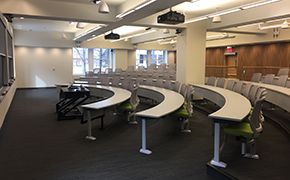Instructor Insights pages are part of the OCW Educator initiative, which seeks to enhance the value of OCW for educators.

Ford Professor of Economics David Autor at work in his office on the MIT campus.
Below, Professor David Autor describes various aspects of how he teaches 14.03 Microeconomic Theory and Public Policy.
- Learning to Think Like an Economist
- Offering Multiple Tools for Mastery
- Common Misconceptions about Economics
- A Roundabout Path to Labor Economics
I was, and still am, interested in the kinds of skills people need to succeed in the workforce, and how those skills are rewarded...I especially care a great deal about how people who are the least well-off are affected by economic opportunity, education, and changes to the labor market.
— David Autor
Curriculum Information
Prerequisites
14.01 Principles of Microeconomics or permission of instructor.
Requirements Satisfied
GIR ![]()
Offered
Every spring and fall semester
Assessment
The students' grades were based on the following activities:
 30% Best five out of six problem set grades
30% Best five out of six problem set grades 60% Three exams
60% Three exams 5% Best of six in-class quizzes
5% Best of six in-class quizzes 5% Class participation
5% Class participationStudent Information

Breakdown by Year
Mostly undergraduates and master’s degree students
Breakdown by Major
1/4 Technology and Public Policy graduate program
3/4 Other
Typical Student Background
Many students in the Technology and Public Policy graduate program come to the course with extremely varied backgrounds. Many have some professional experience.
In the course, we discuss several empirical applications of economic theory in the developing world. We often have students from the focal areas, which enriches our discussions.
During an average week, students were expected to spend 12 hours on the course, roughly divided as follows:
In Class
- Met 2 times per week for 1.5 hours per session; 28 sessions total.
- Students discussed applications from empirical and theoretical papers published in leading journals.
- There were six unannounced quizzes during lecture sessions.
Recitation
- Teaching assistants helped students think through problem sets and conducted exam reviews.
Out of Class
- Students conducted readings, completed problem sets, prepared for exams, and attended optional office hours offered by the instructor.
Semester Breakdown
| WEEK | M | T | W | Th | F |
|---|---|---|---|---|---|
| 1 |  |  |  |  |  |
| 2 |  |  |  |  |  |
| 3 |  |  |  |  |  |
| 4 |  |  |  |  |  |
| 5 |  |  |  |  |  |
| 6 |  |  |  |  |  |
| 7 |  |  |  |  |  |
| 8 |  |  |  |  |  |
| 9 |  |  |  |  |  |
| 10 |  |  |  |  |  |
| 11 |  |  |  |  |  |
| 12 |  |  |  |  |  |
| 13 |  |  |  |  |  |
| 14 |  |  |  |  |  |
| 15 |  |  |  |  |  |
| 16 |  |  |  |  |  |
 No classes throughout MIT
No classes throughout MIT Lecture session
Lecture session Problem set due
Problem set due No class session scheduled
No class session scheduled Recitation
Recitation Exam
Exam

 Room 1 of 1
Room 1 of 1 